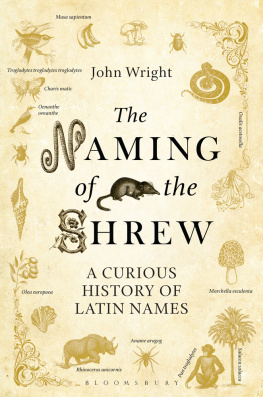The Art of Naming
Michael Ohl
translated by Elisabeth Lauffer
The MIT Press
Cambridge, Massachusetts
London, England
This translation 2018 Massachusetts Institute of Technology
Originally published as Die Kunst der Benennung by Matthes & Seitz Berlin: Matthes & Seitz Berlin Verlagsgesellschaft mbH, Berlin 2015. All rights reserved.
All rights reserved. No part of this book may be reproduced in any form by any electronic or mechanical means (including photocopying, recording, or information storage and retrieval) without permission in writing from the publisher.
This book was set in ITC Stone by Toppan Best-set Premedia Limited. Printed and bound in the United States of America.
Library of Congress Cataloging-in-Publication Data
Names: Ohl, Michael, author.
Title: The art of naming / Michael Ohl ; translated by Elisabeth Lauffer.
Other titles: Kunst der Benennung. English
Description: Cambridge, MA : The MIT Press, [2018] | Originally published as Die Kunst der Benennung. 1. Aufl. Berlin : Matthes et Seitz, 2015. | Includes bibliographical references and index.
Identifiers: LCCN 2017036352 | ISBN 9780262037761 (hardcover : alk. paper)
eISBN 9780262345903
Subjects: LCSH: Biology--Nomenclature. | Biology--Classification.
Classification: LCC QH83 .O3513 2018 | DDC 578.01/2--dc23 LC record available at https://lccn.loc.gov/2017036352
ePub Version 1.0
Prologue: The Beauty of Names
Nature is complicated. All of our efforts to experience and understand its elements and phenomena are channeled through words, whether spoken or written. In no instance is this more evident than in natural history collections. Drawers upon drawers, cabinets upon cabinets of butterflies, insects, fish, and wormslarge and small, colorful and plain, unremarkable and exoticfill the great halls. Natural history museums, each a microcosm of the world, house millions of creatures, but none of the individuals stands for itself alone. Each one has a name, which is usually provided in the form of a label. It is through its name that the individual is bestowed with meaning, and it is through its naming that it becomes part of our perception of nature. Names perform the function of verbal tags that can apply to any imaginable biological entity. Species, which serve as the most important unit of generalization in the natural sciences, thus command the most space in this regard. The standardized and distinct linguistic designation of species follows right on the heels of scientific discovery: one can only name what has been discovered and recognized.
But beyond the sciences, we also name the diversity of organisms in our world, in order to speak about them. Many common names, or even components of names, originate in the distant past of our language, and we must rely on historical linguistics to reconstruct their meaning. Given their largely organic emergence and usage, along with a continuous dynamic of change, vernacular namescompared with scientific labelsare not a suitable standard for the uniform naming of biological species.
Why not? Because there are so many of them. Too many to surrender to the whims of everyday speech. Approximately 1.5 million species have been identified, cataloged, and named, but an additional three, five, ten, or even 100 million are still waiting to be found. And named.
For this reason, organisms are given scientific names that can be used around the world. Scientific names can seem foreign within everyday speech because theyre typically formed with classical linguistic elements following classical linguistic rules. Scientific naming seems to exist at a distance from the public sphere, perhaps even constituting its own hermetic world of specialists. Yet species names are everywhere. Theyre on the endangered species list. Theyre displayed on potted plant markers in every garden shop, like Petunia, Iris, and Chrysanthemum. They can even be found in childrens books, because what dinosaur-obsessed kid doesnt know about Tyrannosaurus rex, Triceratops, or Velociraptor?
Indeed, this is where most people will first experience the delight of scientific names. As though they were secret incantations, these names grant access to the world of those extinct behemoths. Mental images of prehistoric landscapes take shape at the sound of their names, and we feel we are among the initiated, the entrusted, the knowing. For those who know its name, it becomes possible to experience and possess Spinosaurus, that fearsome predator of the Cretaceous Period. It is here that insiders break from the wannabes, those in the know from the amateurs. Thus, the formal name not only reveals the scene of an organism living in its own world, it ushers us into the world of science. A species name conveys authority and knowledge, structuring the living world according to science. A scientific name is, therefore, the culminating point of a range of impressions and connotations, knowledge and interpretations.
Yet scientific names are even more than that. For all their alienness, they are linguistic beauties. Once one has learned to recognize and formulate their component parts, there is no end to the kaleidoscope of words and delightful puzzles they present. Working with names, one enters a complex area of systematic biology and linguistics. The imaginative invention of scientific names for newly discovered species is an especially joyful ritual. The intrinsic satisfaction in naming arises not least from the fact that a name is for eternityor at least for as long as humans continue speaking about nature.
Thus, the ideas presented in this book are outlined. Scientific naming is relevant and important, its ubiquitous, its easier to understand and use than one may think, and its fun. Because subjective and emotional stakes invariably play a part in naming, the art of naming should be told through the example of the artiststhat is to say, the taxonomists for whom the perpetuation of the catalog of life quite often constitutes the center of their own. These people change and enrich our understanding of nature through their discovery and naming of such creatures as the giant panda, the Triceratops, and the pygmy hippopotamus (not to mention the great many insects, slime molds, and flatworms that dont exactly win points for charisma).
Even my perspective is subjective, emotional, and not always unintentionally informed by my zoological and entomological interests, which are largely defined by winged things that stingthat is, wasps, bees, and ants. Wasps are where I make all my discoveries, however, because they are my primary focus as a scientist. I regularly discover new species, and some have even attracted attention outside the scientific sphere, like Megalara garuda, known as the warrior wasp or king of the wasps because of its impressive size, or Ampulex dementor, which was named after the dementors of Harry Potter notoriety. But my personal proclivities represent only one of the reasons for the animal and insect-heaviness of this text. There is no other organism group as species-rich as insects, and the need for names is accordingly highas it always has been.
Many people think that the age of discovery and naming of species has passed. On the contrary, we are right in the middle of it. Every year more new species are discovered and cataloged than ever before, and the key to this ever-growing diversity is scientific names. This book tells their story.
Acknowledgments
Although I wrote the majority of this book at home, overlooking the outskirts of Berlin with my library at my back, its the nature of a project like this that many people contributed to its completion and success. I hope to name all of those people here, and please pardon any unintentional omissions.









